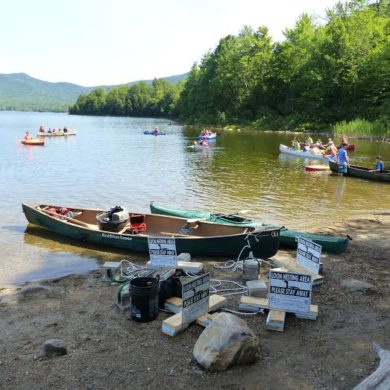
Preparing to add/swap out new sign buoys on Chittenden Reservoir on a warm, sunny day! Photo by Eric Hanson.
Kayaking has always been one of my favorite summer activities, so one can imagine my excitement when I was told that part of my VCE internship would involve paddling around the state of Vermont. During my work with the Vermont Loons Conservation Program, I was able to see so many places in Vermont that I had never visited before, or hadn’t in a very long time. I was amazed once again at the beauty of my home state and very proud to be helping conserve its special biodiversity.
The beginning of my loon work consisted of surveying different nesting habitats on different lakes. Paddling each water body, I would search for and count adults, sub-adults, or chicks, check to see if past nesting sites were currently in use or pairs were using pre-built rafts, determine whether eggs had been abandoned or nests had failed for other reasons, and Identify any floater loons that might be trying to inhabit and/or take over an established pair’s territory. With this information, we were able to help VCE Loon Biologist Eric Hanson determine how successful the loons were on a given lake or pond, and across the entire state.
Once the surveys were complete and loon chicks began to hatch, we shifted our emphasis to sign buoy building, repairing, and swapping. These signs are critical management tools on lakes where loons nest in exposed locations and are especially vulnerable to human disturbance. Again, we took to the water!
Some sign buoys were in need of new rope and swivel hooks, especially those used on more wind exposed lake sites, where strong winds cause the signs to spin and the ropes to fray. We changed the rope and added swivels in the hopes that this new design would relieve the chronic twisting and fraying.
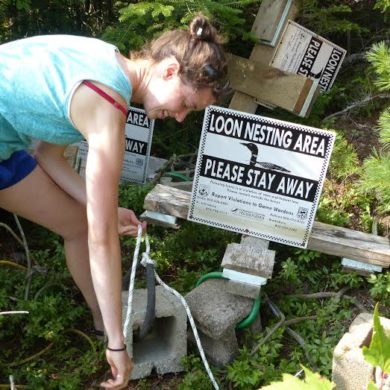
Adding new rope and swivel hooks onto a loon sign buoy. Photo by Eric Hanson.
But we didn’t work only with signs; there were several rafts, or floating nest platforms, that also needed to be evaluated. We ventured to Great Averill Pond in search of a raft that needed to be hauled onto shore to ensure that it would not get damaged by the winter’s freezing ice. The raft was not hard to find, but we had a bit of an adventure dragging it onto land! We hopped out of our boats, reached into the water, released the cinderblocks from the mud’s suction, and pulled the raft free. Combining team work and muscle power, we pulled the raft onto the shore and re-secured until next spring it by dropping the cinderblocks back into their muddy bed.
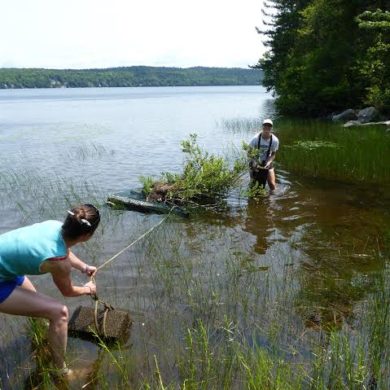
Amber Wolf and Grace Mitchum pulling a loon raft onto shore at Great Averill Pond. Photo by Eric Hanson.
Moving South to Chittenden Reservoir, we pulled another raft from a site where it had been stored on a small island and carefully balanced it onto the gunwales of our canoe. This raft needed to be re-vegetated and moved to a different area of the reservoir where Eric hoped the loons would use it for nesting.
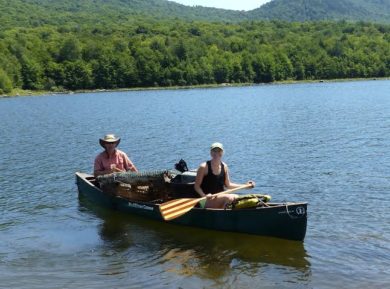
Eric Hanson and Grace Mitchum paddle with the raft balanced on the canoe. Photo by Amber Wolf.
Once we brought the raft to its new destination, it was time for re-vegetation! We docked on shore, hauled shovels out of the canoe, and got right to work. With the three of us digging and replanting, the re-vegetation took no time at all, and soon enough we had a raft built for a lucky pair of loons for next year!
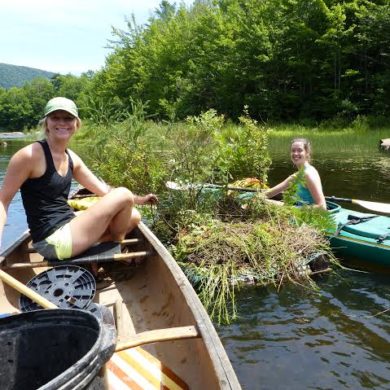
Grace Mitchum and Amber Wolf moving a newly vegetated raft on Chittenden Reservoir. Photo by Eric Hanson.
I certainly can’t complain about spending several days in the sun paddling and observing loons! Over the course of this summer, I surveyed roughly 20 lakes and ponds around the state, making for very rewarding and enjoyable work.
While working with the Loon Conservation Program, I learned a lot about loon behavior, nesting patterns, threats, and their population. It was great for me to see the loons, nests, eggs, and chicks up close (keeping a reasonable distance from the birds, of course) and seeing how the habitat patterns are similar from site to site across the state. I learned that a thrashing loon is not always a hurt loon, but often just a loon doing some “extreme preening”. I was also fortunate enough to talk with some local people about their loon encounters and to hear their stories of what they’ve witnessed over the years. There’s a lot of information that volunteers, and general nature enthusiasts, have to share, and based off of my encounters it’s definitely worth the time to stop and listen.

Someone is sitting in the shade today because another planted a tree a while back. ?